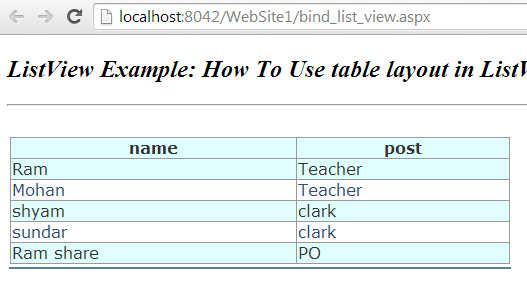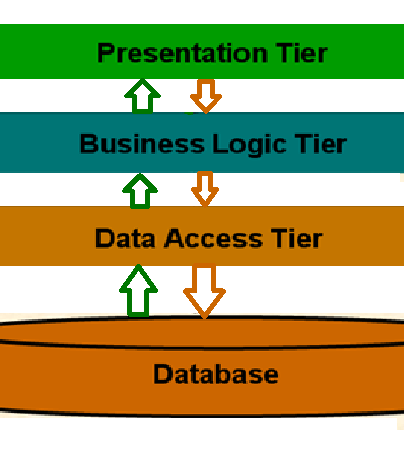What is ASP.net Programming Part 2
Asp.Net Framework Part 2
7. What is mean by JIT?
Just
In Time(JIT) compilers which compile the IL code to native executable code
(.exe or .dll) for the specific machine and OS. JIT are slightly different from
traditional compilers as they compile the IL to native code only when desired
e.g., when a function is called, IL of function's body is converted to native
code; just in time of need. If same function is called next time, the CLR uses
the same copy of native code without re-compiling. As JIT are aware of
processor and OS exactly at runtime, they can optimize the code extremely
efficiently resulting in very robust applications.
8. What are different types of JIT?
Pre-JIT - Pre-JIT compiles complete source code into native code in a
single compilation cycle. This is done at the time of deployment of the
application.
Econo-JIT - Econo-JIT compiles only those functions that are called at
runtime. However, these compiled functions are removed when they are not
required.
Normal-JIT - Normal-JIT compiles only those functions that are called at
runtime and they are stored in cache. If same function is called next time, the
CLR uses the same copy of compiled code without re-compiling.
9. What is mean by Assembly?
Assemblies are self-describing installation units, consisting of
one or more files. Assemblies are the deployment units of .Net applications.
.Net application consists of one or more assemblies. An assembly may also
contain references to other assemblies and it include metadata that describes
all the types that are defined in the assembly with information about it
members-methods, properties, events and fields. One assembly could be a single
Dll or exe that includes metadata, or it can be made of different files e.g
resource files, modules and an exe.Assembly manifests is a part of the
metadata, it describes the assembly with all the information that's needed to
reference it and lists all its dependencies.
10. What are the features of Assembly?
·
Assemblies are self-describing;
it includes metadata that describes the assembly. It does not required to
register key as like COM component.
·
Version dependencies
are recorded inside an assembly manifest. The version of the referenced
assembly that will be used can be configured by the developer and the system
administrator.
·
Two different version
of same assembly can be used inside single process.
11. What are different type's assemblies?
Private assembly- Private assembly is used within your application and it is
installed at the same time as the application itself. It will be located in the
same directory as the application or subdirectories thereof.
Shared assembly- Shared assemblies are used by several applications. Shared
assembly must have version number and unique name and it is usually installed
in GAC (Global assembly catch). It reduces the need for disk space and memory
space.
12. What are parts of assembly manifests?
·
Identity - Name, version,
culture and public key
·
A list of files -
Files belonging to the assembly, it can have one or more files.
·
Lists of referenced
assemblies - all assemblies referenced by the assembly are documented inside
the manifest.
·
Set of permission
requests- these are the permission needed to run the assembly.
·
Exported types - It
describes the structures, class with properties, method and events. It is used
to create instance of the class.
13. What is mean by Namespace?
Namespace
Logically group classes, it avoids name clashes between classes.
Example:
most of the general purpose .net base classes are in a namespace called System.
The base class Array is in this namespace is accessed with full name System.Array.
14. What is difference between Assembly and Namespace?
Assembly
is physical grouping of classes. Namespace logically groups classes.
Single
assembly can have different namespaces
Sample
namespace can be used in different assembly. E.g the assembly mscorlib and
system contain the namespace System.Threading
15. What is the difference between an
executable assembly and a class library?
An
executable assembly exists as the .exe file while a class library exists as the
.dll file. Executable assembly represent executable applications having some
entry (e.g., Main() method in C#). A class library, on the other hand, contains
components and libraries to be used inside various applications. A Class
library cannot be executed and thus it does not have any entry point.
17. What is mean by Manifest?
Manifest is used to describe the information about the assembly,
it contains following information.
·
Assembly name - Aids
in versioning and visibility scope.
·
Version information -
The version number is integrated into the assembly's identity.
·
Types - Boundaries and
scopes of methods, classes, properties, events and attributes.
·
Locale - Information
describing language/culture.
·
Reference - provides
information for type references in an assembly and other referenced assemblies.
·
Cryptographic Hash -
Public key encoded hash acting as version/security check.
·
Security Permissions -
The permissions within the assembly determine the permissions that can be
granted for all aspects of the assembly contents.
18. How will you created shared assembly?
Shared
assembly can be created by signing the assembly. Sets to created shared
assembly
·
Create new class
library project using visual studio
·
Navigate to the
property page of the class library
·
Select
"Signing" tab
·
Select "Sign the
assembly" check-box
·
Now select < New
>... from "Choose a strong name key file" dropdown
·
Enter new Signing key
file name and click Ok
·
Next the build the
project. Now the shared assembly is ready to use in different project.
19. What is the use of Shared Assembly?
If
you want to use the same assembly in different projects, we can create a shared
assembly and placed inside the GAC (Global assembly Catch). So that assembly is
access by all the application. Private assembly also be used in different
projects, but we need to copy the private assembly files to different
application folder. But if we are using Shared assembly, the assembly files
remains in single location. Shared assembly is highly secured, only
administrator can uninstall the shared assembly.
20. What is GAC?
GAC
(Global assembly catch) is used to store .Net assembly. It is located in
"C:\Windows\assembly"
·
Assembly located in
GAC is shared by multiple applications
·
Adding an Assembly to
GAC "gacutil -i (assembly_name)", where (assembly_name) is the DLL
name of the project.
21. What is mean by Delay signing?
During
development process, usually private key will not be exposed to the developer
due to security reason. In this kind of scenario, we will go with delay signing.
DeLay signing allows you to place a shared assembly in the GAC by signing the
assembly with just the public key. This allows the assembly to be signed with
the private key at a later stage, when the development process is complete and
the component or assembly is ready to be deployed. This process enables
developers to work with shared assemblies as if they were strongly named, and
it secures the private key of the signature from being accessed at different
stages of development.E.g
VB.Net
(Assemblyinfo.vb)
<Assembly:AssemblyKeyFileAttribute("myKey.snk")>
< Assembly: AssemblyDelaySignAttribute(True)
>
C#(Assemblyinfo.cs)
[assembly:
AssemblyKeyFileAttribute("myKey.snk")]
[assembly:
AssemblyDelaySignAttribute(true)]
22. What is mean by Satellite assembly?
When
we write a multilingual or multi-cultural application in .NET, and want to
distribute the core application separately from the localized modules, the
localized assemblies that modify the core application are called satellite
assemblies.
23. What is portable executable (PE)?
The
file format defining the structure that all executable files (EXE) and Dynamic
Link Libraries (DLL) must use to allow them to be loaded and executed by
Windows. PE is derived from the Microsoft Common Object File Format (COFF). The
EXE and DLL files created using the .NET Framework obey the PE/COFF formats and
also add additional header and data sections to the files that are only used by
the CLR.
24. What is mean by Garbage collection?
Garbage
collection is a CLR features used to automatically manages memory. CLR
automatically release the objects which are not longer used or referenced. Developer
who forgets to release the dispose the objects will be cleared by GC. But it is
not known when GC will be called by CLR to clean the memory. So better we can
dispose the objects once it is used.
25. What are the different levels of GC is
available?
Generation
0 , Generation 1, Generation 2
26. How Garbage collector will get memory from
OS?
When
execution engine starts, GC will initialize segment of memory for its
operation. GC reserves memory in segment, each segment is 16MB. When we run out
of segments we reserve a new segment. If a segment of memory is not in use, it
will be deleted.
28. What are situations GC will be called?
- If user
forcefully calls System.GC.Collect
- System
is in low memory situation
- Memory
allocation exceeds the Generation0 threshold
29. What is mean by value type and Reference
type?
Value
type- Value type stores their value directly to memory address. Value type's
values are allocated on the stack memory.
Reference
type - Reference type stores the reference to the value's memory address.
Reference type values are allocated on head memory.
30. What is mean by Boxing and Unboxing?
Boxing
- Converting value type variable to reference type is called as boxing
UnBoxing
- Converting reference type variable to value type is called as unboxing
int vType = 35;
object rType;
//Boxing process
rType = vType;
//Unboxing process
vType =(int) rType;
Asp.net Related other Post:
- Print pdf file in asp.net by C sharp
- SQL Server questions for interview
- Find datetime difference in asp.net by C#
- Add rows in GridView dynamic with Textbox
- Asp.net Watermark Text on uploaded Image
- Asp.net NullReferenceException and how fix it
- State Management and type of State Management
- Cookies,how to make Cookies in asp.net with C#.
- Jquery Change div background on mouseover in asp.net
- In asp.net by jquery change div text color on mouseover
- Upload multiple by one asp.net fileupload control using jQuery
- Adding Dynamic Rows in ASP.Net GridView Control with Textbox
- In Asp.net Difference between ""(empty string) and String.Empty
- Validation checkbox control using JavaScript
- Validate ASP.Net RadioButtonList using JavaScript Example


Comments
Post a Comment